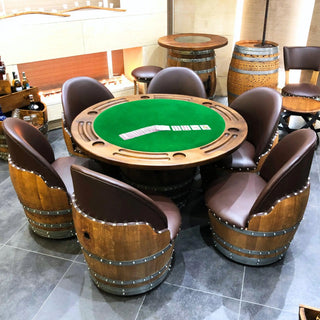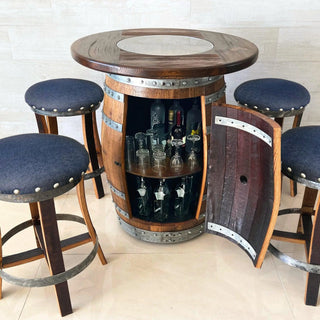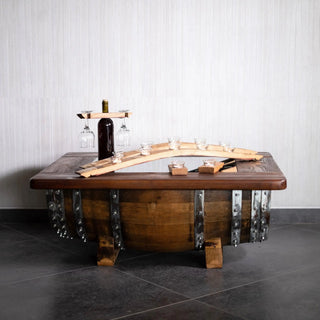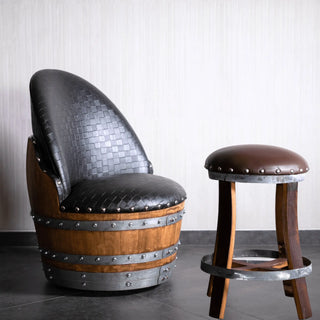How to Keep Barrel Hoops Tight: Simple Fixes That Save Your Barrel
There’s something timeless about a well-built oak barrel.
The curves, the grain, that faint aroma of old wine that never quite leaves—it’s a piece of living history sitting right in your home. Whether you’ve got a full barrel bar set, a rustic wine barrel coffee table, or a decorative reclaimed oak piece on your patio, one thing’s guaranteed: those metal hoops are what hold it all together.
And when they start to loosen? You’ll notice. A wobbly hoop or a slight shift in the staves can make the whole barrel look uneven or even unstable. Luckily, keeping your hoops tight isn’t rocket science—it’s part patience, part finesse, and maybe a little bit of love for good craftsmanship.
So, let’s talk about how to tighten those hoops and give your barrel furniture the care it deserves.
Understanding Why Barrel Hoops Loosen
If you’ve owned oak barrel furniture for a while, you’ve probably noticed that the hoops—the metal bands hugging the barrel—can loosen up. That’s not poor craftsmanship; that’s nature doing its thing.
When oak dries out, it shrinks. When it absorbs moisture, it expands. That constant dance is what can make the hoops slip down over time, especially if your barrel moved from a humid winery to your climate-controlled living room.
In my experience, the change in humidity is the biggest culprit. I’ve seen barrels that were perfectly tight in a Napa cellar start to wiggle once they hit a dry suburban home. But don’t worry—this is one of those “fixable with a Saturday afternoon” kind of problems.
Quick Inspection: Is Your Barrel Just Settling or Actually Loose?
Before you grab a mallet or start misting water everywhere, take a closer look:
- Are the hoops visibly sliding down?
- Do you see tiny gaps forming between the oak staves?
- Has the wood lost its sheen or gone a bit gray and dry?
- When you tap on the side, does it sound hollow instead of tight?
If you nodded “yes” to any of those, it’s time for a little maintenance.
Step 1: Hydrate the Wood (Seriously, It Works)
This is the simplest trick—and the one most people forget. Real oak barrels were designed to hold liquid, which means the wood was made to swell. If your barrel’s gotten dry, reintroducing moisture can naturally tighten those hoops back up.
Here’s what I usually do:
- Give the barrel a gentle mist with water.
- Wrap a damp towel around it and leave it overnight.
- Let the wood absorb that moisture slowly—no soaking or pouring water directly!
By morning, you’ll often see the hoops have hugged the staves again like a good handshake. It’s one of those small woodworking miracles that never gets old.
Step 2: Tap the Hoops Back Into Place
If a hoop has slipped too far down, a little manual encouragement can help.
You’ll need:
- A rubber mallet or small wooden block
- A soft towel (to protect the metal finish)
- Steady hands
Wrap the towel around the hoop, then use the mallet to gently tap upward. Don’t go full Thor here—just light, consistent taps until the band slides back into its groove.
And if your barrel is one of those engraved or custom-finished ones from Oak Wood Wine Barrels, use even less force. The goal is precision, not speed.
Step 3: Add a Hoop Tightening Wedge (Optional Trick from the Workshop)
Here’s a pro tip I picked up while restoring a whiskey barrel pub table: use a tiny wooden shim or wedge beneath the hoop lip. It adds just enough pressure to keep everything snug without being visible.
This trick works wonders on wine barrel coffee tables and oak barrel bar sets that sit indoors year-round, especially where humidity fluctuates.
Step 4: Seal and Protect the Wood
Once the hoops are tight again, give that oak some nourishment. A coat of linseed oil, tung oil, or a natural furniture wax will bring out the rich tones and help the wood hold its moisture longer.
If your barrel is outdoors, use an exterior-grade oil or polyurethane finish. At Oak Wood Wine Barrels, we usually tell customers to reapply every 4–6 months—especially if their barrels are exposed to sunlight or seasonal weather swings.
There’s nothing quite like seeing that deep caramel color return after a good oiling.
Workshop Wisdom: Little Habits That Make a Big Difference
- Don’t store barrels near heaters or air vents—the heat dries them out fast.
- Avoid leaving barrels directly on concrete floors; add a mat or wood base to balance humidity.
- Give your barrels a light mist once a month if your home’s air is dry.
- For decorative pieces, a thin foam insert under the hoop can keep it from sliding again (a little-known trick among restorers).
Sometimes, the smallest tweaks make your furniture last decades longer.
When to Call in the Pros
If you’re working with an antique barrel, a collectible whiskey cask, or a cracked stave, that’s when you might want to call a professional. Tightening hoops is easy—but replacing them or repairing a split stave is a job best left to experienced hands.
At Oak Wood Wine Barrels, we’ve restored everything from vintage Napa barrels to custom luxury wine barrel bar sets. Sometimes, what looks like a “lost cause” just needs the right touch (and a good polish) to come back to life.
Our Links
- Explore our handcrafted oak barrel furniture sets
- Learn more about barrel bar furniture and rustic home bar ideas
- Browse our collection of wine barrel coffee tables and reclaimed oak seating sets
Other Resources to Check Out!
- Cooperage 101: How Wine Barrels Are Built and Repaired
- Fine Woodworking: Oak Furniture Care & Restoration
- The American Cooper’s Guild: Barrel Craftsmanship and Preservation
Barrels tell stories. Every nick, every burnished hoop, every aroma of oak is part of its life. Keeping those hoops tight isn’t just about maintenance—it’s about respect for the craft.
Because when you care for your barrel, you’re not just saving a piece of furniture…
you’re keeping a slice of tradition alive.
Disclaimer
This blog post is intended for informational and educational purposes only. The techniques and suggestions provided reflect general woodworking practices and personal experience and should not replace professional assessment for valuable or antique pieces. Always use appropriate safety gear, tools, and methods when restoring or modifying wood furniture.
Oak Wood Wine Barrels assumes no responsibility for any injuries, damages, or unintended results arising from self-repair attempts. Product specifications, finishes, and designs may evolve as we refine our craftsmanship. For expert restoration or maintenance, contact our team directly through OBARREL.COM — we’re always happy to help keep your barrels strong, beautiful, and built to last.




